CHEVROLET IMPALA 2010 9.G Owners Manual
Manufacturer: CHEVROLET, Model Year: 2010, Model line: IMPALA, Model: CHEVROLET IMPALA 2010 9.GPages: 432, PDF Size: 1.89 MB
Page 401 of 432
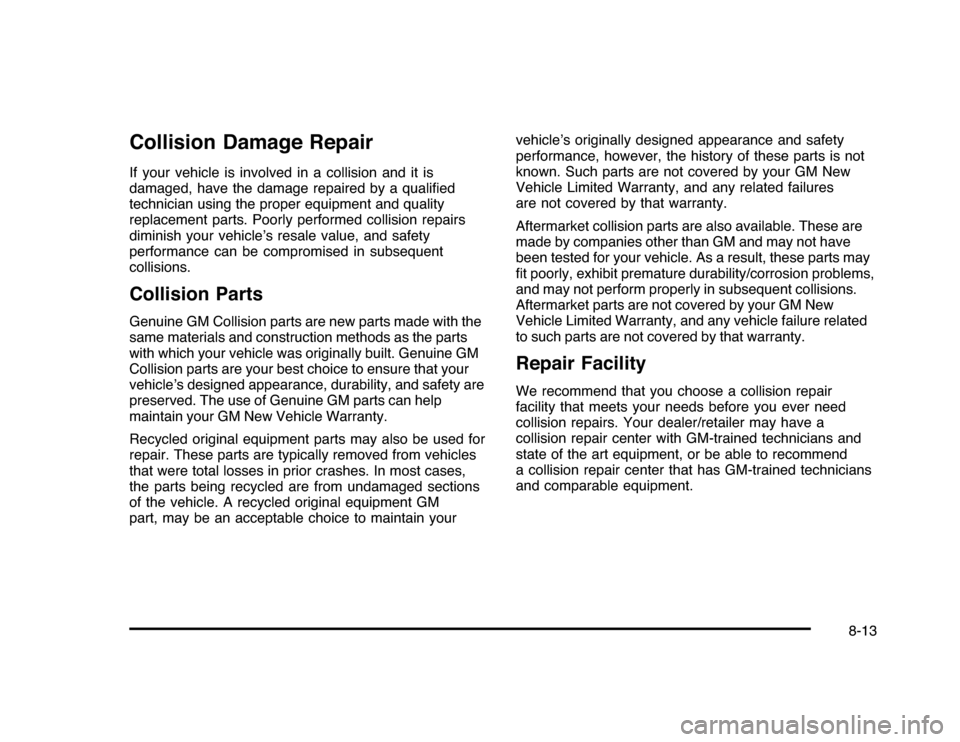
Collision Damage RepairIf your vehicle is involved in a collision and it is
damaged, have the damage repaired by a qualified
technician using the proper equipment and quality
replacement parts. Poorly performed collision repairs
diminish your vehicle’s resale value, and safety
performance can be compromised in subsequent
collisions.Collision PartsGenuine GM Collision parts are new parts made with the
same materials and construction methods as the parts
with which your vehicle was originally built. Genuine GM
Collision parts are your best choice to ensure that your
vehicle’s designed appearance, durability, and safety are
preserved. The use of Genuine GM parts can help
maintain your GM New Vehicle Warranty.
Recycled original equipment parts may also be used for
repair. These parts are typically removed from vehicles
that were total losses in prior crashes. In most cases,
the parts being recycled are from undamaged sections
of the vehicle. A recycled original equipment GM
part, may be an acceptable choice to maintain yourvehicle’s originally designed appearance and safety
performance, however, the history of these parts is not
known. Such parts are not covered by your GM New
Vehicle Limited Warranty, and any related failures
are not covered by that warranty.
Aftermarket collision parts are also available. These are
made by companies other than GM and may not have
been tested for your vehicle. As a result, these parts may
fit poorly, exhibit premature durability/corrosion problems,
and may not perform properly in subsequent collisions.
Aftermarket parts are not covered by your GM New
Vehicle Limited Warranty, and any vehicle failure related
to such parts are not covered by that warranty.
Repair FacilityWe recommend that you choose a collision repair
facility that meets your needs before you ever need
collision repairs. Your dealer/retailer may have a
collision repair center with GM-trained technicians and
state of the art equipment, or be able to recommend
a collision repair center that has GM-trained technicians
and comparable equipment.
8-13
Page 402 of 432
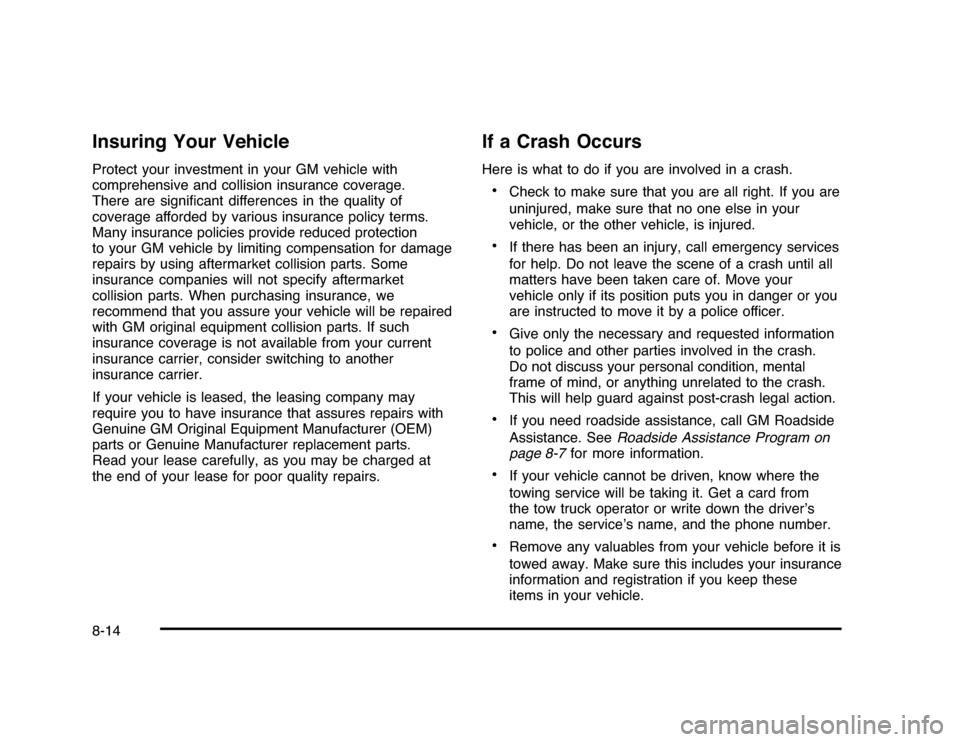
Insuring Your VehicleProtect your investment in your GM vehicle with
comprehensive and collision insurance coverage.
There are significant differences in the quality of
coverage afforded by various insurance policy terms.
Many insurance policies provide reduced protection
to your GM vehicle by limiting compensation for damage
repairs by using aftermarket collision parts. Some
insurance companies will not specify aftermarket
collision parts. When purchasing insurance, we
recommend that you assure your vehicle will be repaired
with GM original equipment collision parts. If such
insurance coverage is not available from your current
insurance carrier, consider switching to another
insurance carrier.
If your vehicle is leased, the leasing company may
require you to have insurance that assures repairs with
Genuine GM Original Equipment Manufacturer (OEM)
parts or Genuine Manufacturer replacement parts.
Read your lease carefully, as you may be charged at
the end of your lease for poor quality repairs.
If a Crash OccursHere is what to do if you are involved in a crash.•
Check to make sure that you are all right. If you are
uninjured, make sure that no one else in your
vehicle, or the other vehicle, is injured.
•
If there has been an injury, call emergency services
for help. Do not leave the scene of a crash until all
matters have been taken care of. Move your
vehicle only if its position puts you in danger or you
are instructed to move it by a police officer.
•
Give only the necessary and requested information
to police and other parties involved in the crash.
Do not discuss your personal condition, mental
frame of mind, or anything unrelated to the crash.
This will help guard against post-crash legal action.
•
If you need roadside assistance, call GM Roadside
Assistance. SeeRoadside Assistance Program on
page 8-7for more information.
•
If your vehicle cannot be driven, know where the
towing service will be taking it. Get a card from
the tow truck operator or write down the driver’s
name, the service’s name, and the phone number.
•
Remove any valuables from your vehicle before it is
towed away. Make sure this includes your insurance
information and registration if you keep these
items in your vehicle.
8-14
Page 403 of 432
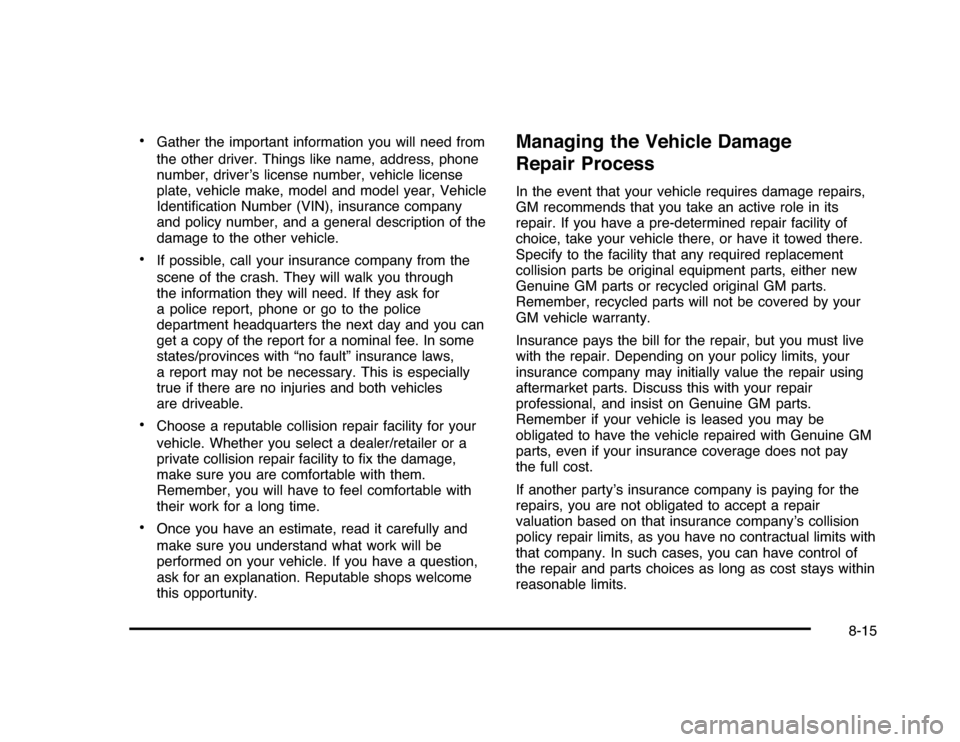
•
Gather the important information you will need from
the other driver. Things like name, address, phone
number, driver’s license number, vehicle license
plate, vehicle make, model and model year, Vehicle
Identification Number (VIN), insurance company
and policy number, and a general description of the
damage to the other vehicle.
•
If possible, call your insurance company from the
scene of the crash. They will walk you through
the information they will need. If they ask for
a police report, phone or go to the police
department headquarters the next day and you can
get a copy of the report for a nominal fee. In some
states/provinces with “no fault” insurance laws,
a report may not be necessary. This is especially
true if there are no injuries and both vehicles
are driveable.
•
Choose a reputable collision repair facility for your
vehicle. Whether you select a dealer/retailer or a
private collision repair facility to fix the damage,
make sure you are comfortable with them.
Remember, you will have to feel comfortable with
their work for a long time.
•
Once you have an estimate, read it carefully and
make sure you understand what work will be
performed on your vehicle. If you have a question,
ask for an explanation. Reputable shops welcome
this opportunity.
Managing the Vehicle Damage
Repair ProcessIn the event that your vehicle requires damage repairs,
GM recommends that you take an active role in its
repair. If you have a pre-determined repair facility of
choice, take your vehicle there, or have it towed there.
Specify to the facility that any required replacement
collision parts be original equipment parts, either new
Genuine GM parts or recycled original GM parts.
Remember, recycled parts will not be covered by your
GM vehicle warranty.
Insurance pays the bill for the repair, but you must live
with the repair. Depending on your policy limits, your
insurance company may initially value the repair using
aftermarket parts. Discuss this with your repair
professional, and insist on Genuine GM parts.
Remember if your vehicle is leased you may be
obligated to have the vehicle repaired with Genuine GM
parts, even if your insurance coverage does not pay
the full cost.
If another party’s insurance company is paying for the
repairs, you are not obligated to accept a repair
valuation based on that insurance company’s collision
policy repair limits, as you have no contractual limits with
that company. In such cases, you can have control of
the repair and parts choices as long as cost stays within
reasonable limits.
8-15
Page 404 of 432
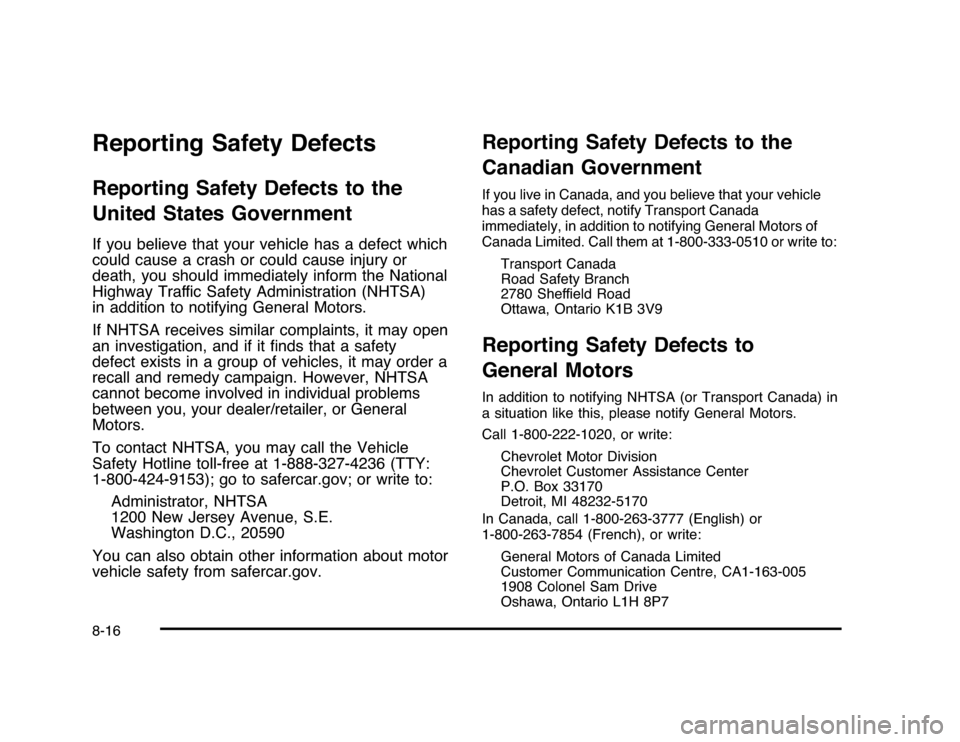
Reporting Safety DefectsReporting Safety Defects to the
United States GovernmentIf you believe that your vehicle has a defect which
could cause a crash or could cause injury or
death, you should immediately inform the National
Highway Traffic Safety Administration (NHTSA)
in addition to notifying General Motors.
If NHTSA receives similar complaints, it may open
an investigation, and if it finds that a safety
defect exists in a group of vehicles, it may order a
recall and remedy campaign. However, NHTSA
cannot become involved in individual problems
between you, your dealer/retailer, or General
Motors.
To contact NHTSA, you may call the Vehicle
Safety Hotline toll-free at 1-888-327-4236 (TTY:
1-800-424-9153); go to safercar.gov; or write to:
Administrator, NHTSA
1200 New Jersey Avenue, S.E.
Washington D.C., 20590
You can also obtain other information about motor
vehicle safety from safercar.gov.
Reporting Safety Defects to the
Canadian GovernmentIf you live in Canada, and you believe that your vehicle
has a safety defect, notify Transport Canada
immediately, in addition to notifying General Motors of
Canada Limited. Call them at 1-800-333-0510 or write to:
Transport Canada
Road Safety Branch
2780 Sheffield Road
Ottawa, Ontario K1B 3V9Reporting Safety Defects to
General MotorsIn addition to notifying NHTSA (or Transport Canada) in
a situation like this, please notify General Motors.
Call 1-800-222-1020, or write:
Chevrolet Motor Division
Chevrolet Customer Assistance Center
P.O. Box 33170
Detroit, MI 48232-5170
In Canada, call 1-800-263-3777 (English) or
1-800-263-7854 (French), or write:
General Motors of Canada Limited
Customer Communication Centre, CA1-163-005
1908 Colonel Sam Drive
Oshawa, Ontario L1H 8P7
8-16
Page 405 of 432
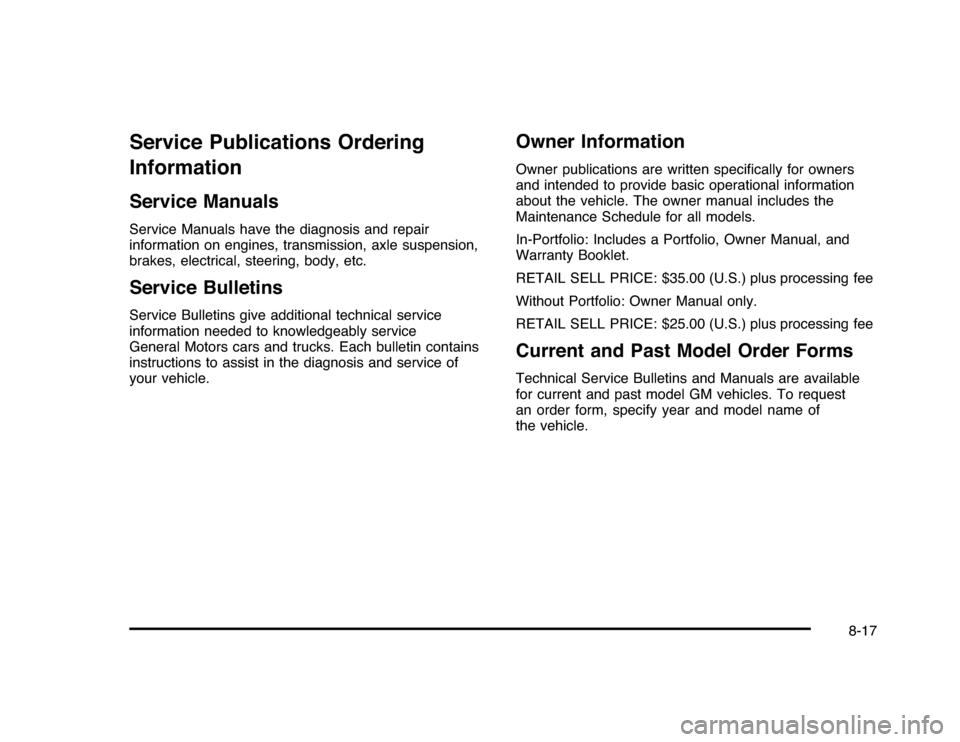
Service Publications Ordering
InformationService ManualsService Manuals have the diagnosis and repair
information on engines, transmission, axle suspension,
brakes, electrical, steering, body, etc.Service BulletinsService Bulletins give additional technical service
information needed to knowledgeably service
General Motors cars and trucks. Each bulletin contains
instructions to assist in the diagnosis and service of
your vehicle.
Owner InformationOwner publications are written specifically for owners
and intended to provide basic operational information
about the vehicle. The owner manual includes the
Maintenance Schedule for all models.
In-Portfolio: Includes a Portfolio, Owner Manual, and
Warranty Booklet.
RETAIL SELL PRICE: $35.00 (U.S.) plus processing fee
Without Portfolio: Owner Manual only.
RETAIL SELL PRICE: $25.00 (U.S.) plus processing feeCurrent and Past Model Order FormsTechnical Service Bulletins and Manuals are available
for current and past model GM vehicles. To request
an order form, specify year and model name of
the vehicle.
8-17
Page 406 of 432
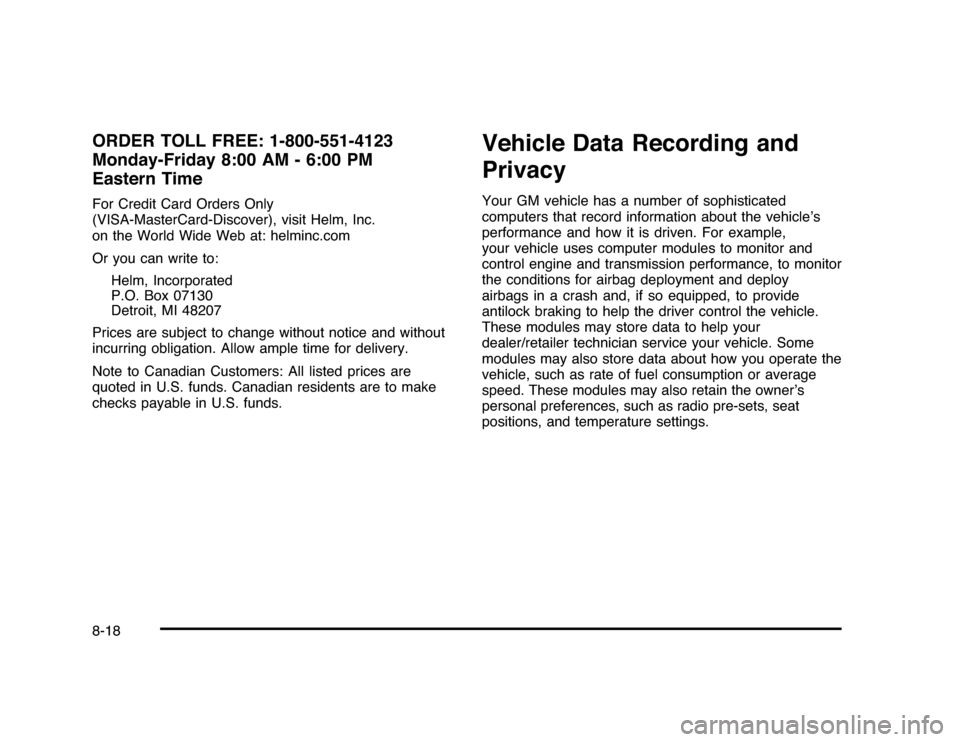
ORDER TOLL FREE: 1-800-551-4123
Monday-Friday 8:00 AM - 6:00 PM
Eastern TimeFor Credit Card Orders Only
(VISA-MasterCard-Discover), visit Helm, Inc.
on the World Wide Web at: helminc.com
Or you can write to:
Helm, Incorporated
P.O. Box 07130
Detroit, MI 48207
Prices are subject to change without notice and without
incurring obligation. Allow ample time for delivery.
Note to Canadian Customers: All listed prices are
quoted in U.S. funds. Canadian residents are to make
checks payable in U.S. funds.
Vehicle Data Recording and
PrivacyYour GM vehicle has a number of sophisticated
computers that record information about the vehicle’s
performance and how it is driven. For example,
your vehicle uses computer modules to monitor and
control engine and transmission performance, to monitor
the conditions for airbag deployment and deploy
airbags in a crash and, if so equipped, to provide
antilock braking to help the driver control the vehicle.
These modules may store data to help your
dealer/retailer technician service your vehicle. Some
modules may also store data about how you operate the
vehicle, such as rate of fuel consumption or average
speed. These modules may also retain the owner’s
personal preferences, such as radio pre-sets, seat
positions, and temperature settings.
8-18
Page 407 of 432
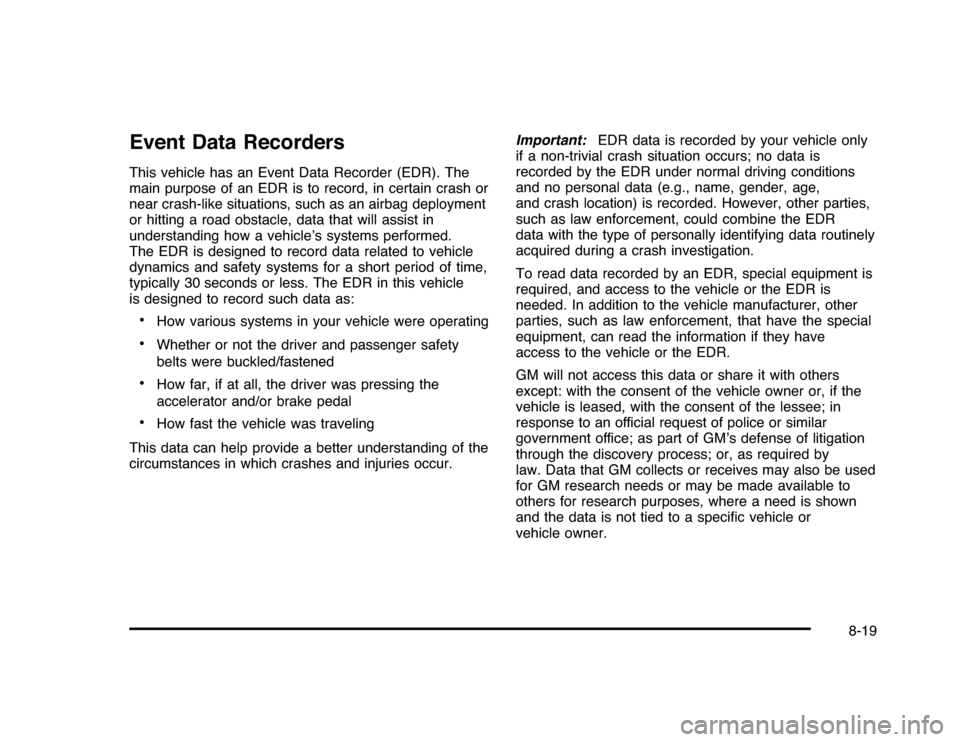
Event Data RecordersThis vehicle has an Event Data Recorder (EDR). The
main purpose of an EDR is to record, in certain crash or
near crash-like situations, such as an airbag deployment
or hitting a road obstacle, data that will assist in
understanding how a vehicle’s systems performed.
The EDR is designed to record data related to vehicle
dynamics and safety systems for a short period of time,
typically 30 seconds or less. The EDR in this vehicle
is designed to record such data as:•
How various systems in your vehicle were operating
•
Whether or not the driver and passenger safety
belts were buckled/fastened
•
How far, if at all, the driver was pressing the
accelerator and/or brake pedal
•
How fast the vehicle was traveling
This data can help provide a better understanding of the
circumstances in which crashes and injuries occur.Important:EDR data is recorded by your vehicle only
if a non-trivial crash situation occurs; no data is
recorded by the EDR under normal driving conditions
and no personal data (e.g., name, gender, age,
and crash location) is recorded. However, other parties,
such as law enforcement, could combine the EDR
data with the type of personally identifying data routinely
acquired during a crash investigation.
To read data recorded by an EDR, special equipment is
required, and access to the vehicle or the EDR is
needed. In addition to the vehicle manufacturer, other
parties, such as law enforcement, that have the special
equipment, can read the information if they have
access to the vehicle or the EDR.
GM will not access this data or share it with others
except: with the consent of the vehicle owner or, if the
vehicle is leased, with the consent of the lessee; in
response to an official request of police or similar
government office; as part of GM’s defense of litigation
through the discovery process; or, as required by
law. Data that GM collects or receives may also be used
for GM research needs or may be made available to
others for research purposes, where a need is shown
and the data is not tied to a specific vehicle or
vehicle owner.
8-19
Page 408 of 432
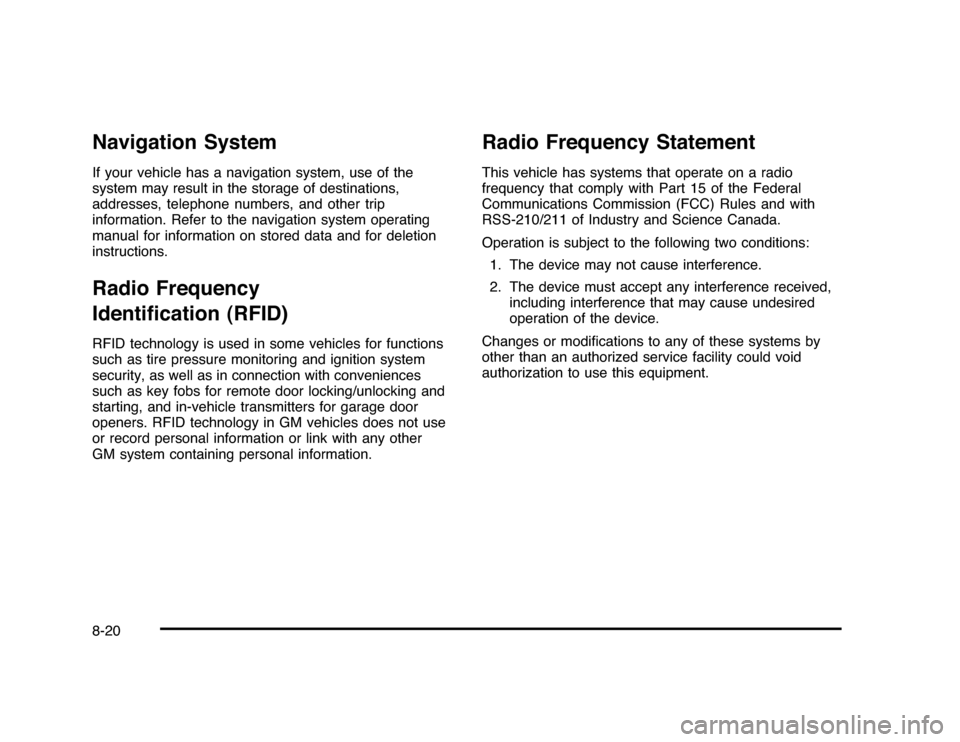
Navigation SystemIf your vehicle has a navigation system, use of the
system may result in the storage of destinations,
addresses, telephone numbers, and other trip
information. Refer to the navigation system operating
manual for information on stored data and for deletion
instructions.Radio Frequency
Identification (RFID)RFID technology is used in some vehicles for functions
such as tire pressure monitoring and ignition system
security, as well as in connection with conveniences
such as key fobs for remote door locking/unlocking and
starting, and in-vehicle transmitters for garage door
openers. RFID technology in GM vehicles does not use
or record personal information or link with any other
GM system containing personal information.
Radio Frequency StatementThis vehicle has systems that operate on a radio
frequency that comply with Part 15 of the Federal
Communications Commission (FCC) Rules and with
RSS-210/211 of Industry and Science Canada.
Operation is subject to the following two conditions:
1. The device may not cause interference.
2. The device must accept any interference received,
including interference that may cause undesired
operation of the device.
Changes or modifications to any of these systems by
other than an authorized service facility could void
authorization to use this equipment.
8-20
Page 409 of 432
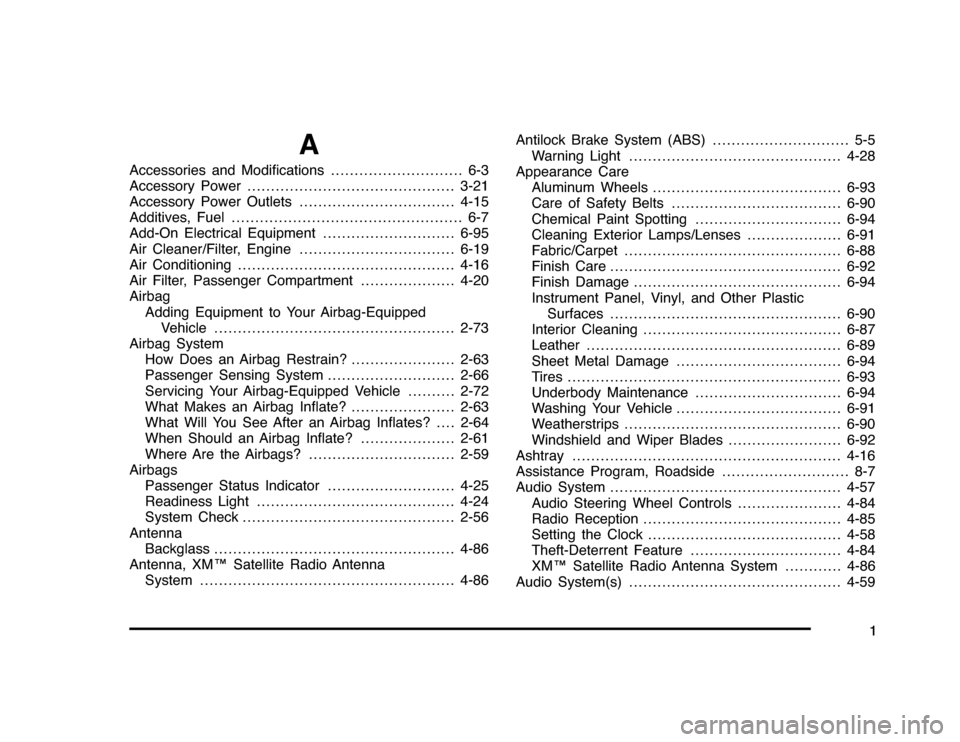
A
Accessories and Modifications............................ 6-3
Accessory Power............................................3-21
Accessory Power Outlets . ................................4-15
Additives, Fuel................................................. 6-7
Add-On Electrical Equipment............................6-95
Air Cleaner/Filter, Engine . ................................6-19
Air Conditioning..............................................4-16
Air Filter, Passenger Compartment . . ..................4-20
Airbag
Adding Equipment to Your Airbag-Equipped
Vehicle ...................................................2-73
Airbag System
How Does an Airbag Restrain?......................2-63
Passenger Sensing System...........................2-66
Servicing Your Airbag-Equipped Vehicle..........2-72
What Makes an Airbag Inflate?......................2-63
What Will You See After an Airbag Inflates? . . . . 2-64
When Should an Airbag Inflate? . . ..................2-61
Where Are the Airbags?...............................2-59
Airbags
Passenger Status Indicator...........................4-25
Readiness Light..........................................4-24
System Check.............................................2-56
Antenna
Backglass ...................................................4-86
Antenna, XM™ Satellite Radio Antenna
System . . ....................................................4-86Antilock Brake System (ABS)............................. 5-5
Warning Light.............................................4-28
Appearance Care
Aluminum Wheels........................................6-93
Care of Safety Belts....................................6-90
Chemical Paint Spotting . . . . . ..........................6-94
Cleaning Exterior Lamps/Lenses....................6-91
Fabric/Carpet..............................................6-88
Finish Care.................................................6-92
Finish Damage............................................6-94
Instrument Panel, Vinyl, and Other Plastic
Surfaces.................................................6-90
Interior Cleaning..........................................6-87
Leather......................................................6-89
Sheet Metal Damage . . .................................6-94
Tires..........................................................6-93
Underbody Maintenance . . . . . ..........................6-94
Washing Your Vehicle . . . . ...............................6-91
Weatherstrips..............................................6-90
Windshield and Wiper Blades........................6-92
Ashtray.........................................................4-16
Assistance Program, Roadside........................... 8-7
Audio System.................................................4-57
Audio Steering Wheel Controls . . ....................4-84
Radio Reception..........................................4-85
Setting the Clock.........................................4-58
Theft-Deterrent Feature................................4-84
XM™ Satellite Radio Antenna System . . . . . . . . . . . . 4-86
Audio System(s).............................................4-59
1
Page 410 of 432
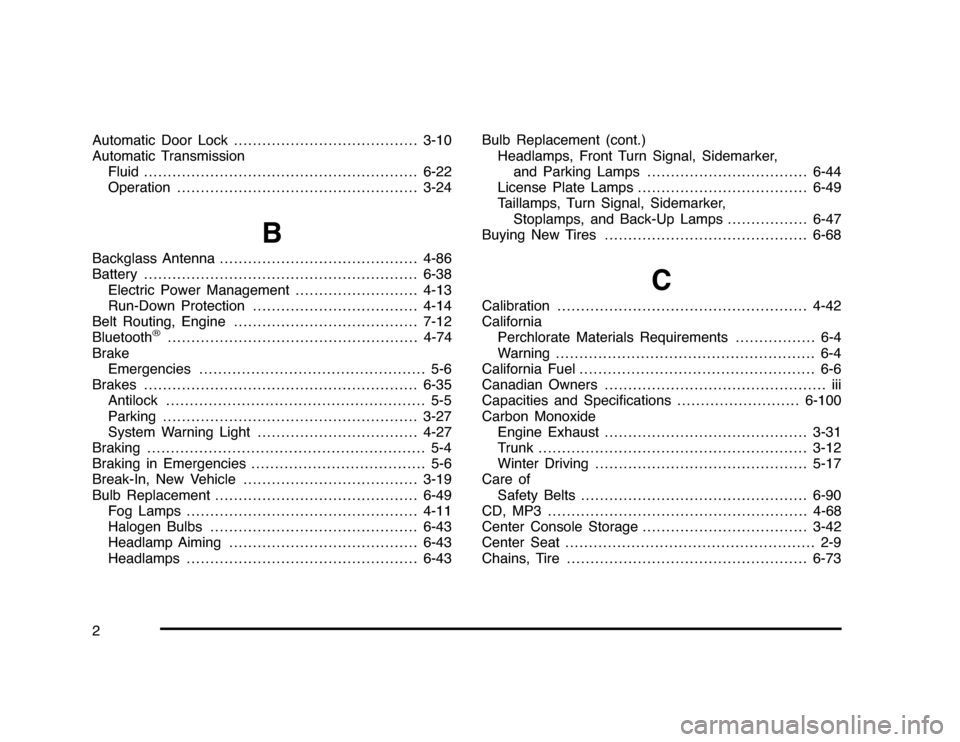
Automatic Door Lock.......................................3-10
Automatic Transmission
Fluid . . . . . . . . . .................................................6-22
Operation . . . . . . . ............................................3-24
B
Backglass Antenna..........................................4-86
Battery . . . . . . . ...................................................6-38
Electric Power Management..........................4-13
Run-Down Protection...................................4-14
Belt Routing, Engine.......................................7-12
Bluetooth
®
.....................................................4-74
Brake
Emergencies................................................ 5-6
Brakes . . . . . . . ...................................................6-35
Antilock....................................................... 5-5
Parking......................................................3-27
System Warning Light..................................4-27
Braking . . . . . ...................................................... 5-4
Braking in Emergencies..................................... 5-6
Break-In, New Vehicle.....................................3-19
Bulb Replacement...........................................6-49
Fog Lamps . . . . . . ...........................................4-11
Halogen Bulbs............................................6-43
Headlamp Aiming........................................6-43
Headlamps . . . . . . ...........................................6-43Bulb Replacement (cont.)
Headlamps, Front Turn Signal, Sidemarker,
and Parking Lamps..................................6-44
License Plate Lamps....................................6-49
Taillamps, Turn Signal, Sidemarker,
Stoplamps, and Back-Up Lamps.................6-47
Buying New Tires...........................................6-68
C
Calibration.....................................................4-42
California
Perchlorate Materials Requirements................. 6-4
Warning....................................................... 6-4
California Fuel.................................................. 6-6
Canadian Owners............................................... iii
Capacities and Specifications..........................6-100
Carbon Monoxide
Engine Exhaust...........................................3-31
Trunk.........................................................3-12
Winter Driving.............................................5-17
Care of
Safety Belts................................................6-90
CD, MP3 .......................................................4-68
Center Console Storage...................................3-42
Center Seat..................................................... 2-9
Chains, Tire...................................................6-73
2